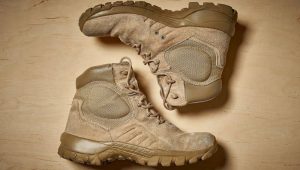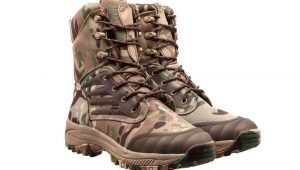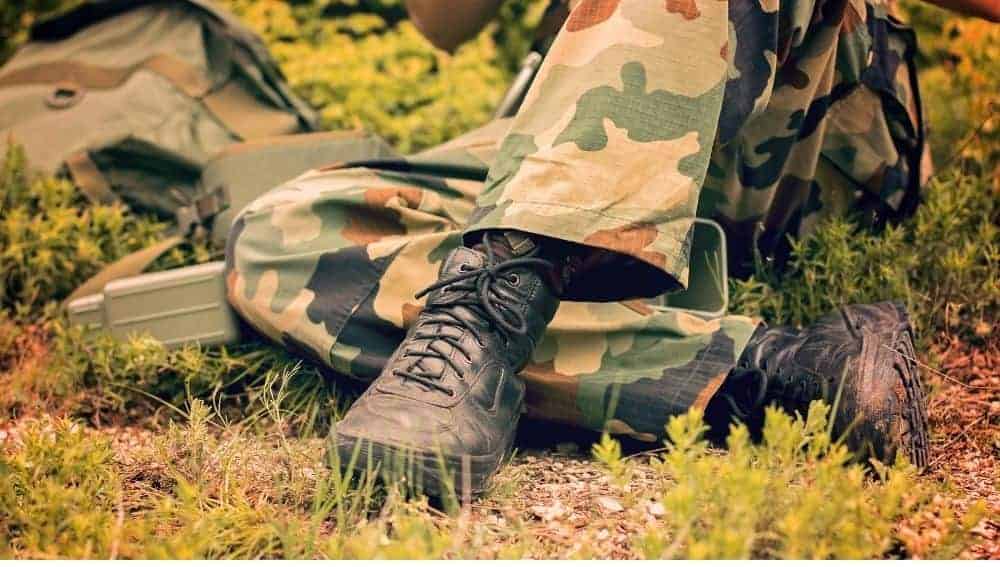Tactical boots are one of the most versatile boots in the world. They are born to serve military service, the air force, law enforcement, task force, police, and more.
Tactical boots are widely used in many professions, and also a favorite accessory for outdoor hikes (hiking, expeditions, climbing…).
In general, tactical boots offer high flexibility, good durability, safety and especially comfort so they are best for demanding jobs as well as long-term use.
However, all of the above only happens when you get suitable tactical boots for your purpose. Why is that?
The reason is that tactical boots don’t just have a single type but they come in many different types. For a great experience, you need to choose the right tactical boots that will suit your intended use.
When using tactical boots, other factors also affect your wearing experience such as size, fit, design, etc.
Too much? Don’t worry! Today, we will guide you all in the simplest way!
Join us in the article of How to choose tactical boots!
Let’s get it started!
How to choose tactical boots?
Hmmm… Where should we start?
First of all, you should determine the purpose of using your tactical boots, and then choose a pair with the matching features for your needs.
Next, learn how to choose the right tactical boots by researching the size chart of the tactical boots you’re planning to buy.
Ultimately, you can select the tactical boots after determining all the features that are right for your job, like their sizes and how they should fit.
For now, let’s find out what type of tactical boots you need!

Guide to choosing types of tactical boots
Tactical boots used for each profession (police, firefighter, military, law enforcement…) will have different pros and cons. Overall, we can divide tactical boots into two main categories: tactical boots for hot weather and tactical boots for the nasty, wet weather.
Tactical boots for the hot weather
As its name implies, the hot weather tactical boots are often used in the summer, dry, and high-temperature weather.
Hot weather tactical boots have the important feature of being breathable. In addition, they circulate air inside the boot pretty well to keep your feet from getting hot.
These are the two most important traits that distinguish the hot from the wet weather tactical boots.
If you are a lover of outdoor sports in the summer, opt for tactical boots made from suede, nylon fabric or full grain leather. These three materials are breathable and feature better air circulation for tactical boots .
Besides, hot weather tactical boots are lightweight. For the uninitiated, tactical boots are often seen as a new style of traditional military boots, so they are lighter and more versatile.
There are a variety of hybrid tactical boots with hiking boots that are lightweight too. These boots are a good suggestion for those who enjoy long trips on warm, sunny summer days.
Aside from that, summer tactical boots often have moisture-wicking lining to make sure your feet stay dry no matter how they sweat.
Tactical boots for wet and nasty weather
Speaking of the biggest difference between wet and hot weather tactical boots, the wet weather tactical boots are waterproof, quick dry, easy to clean, and insulated.
These are the basic features that the wet weather tactical boots should have. With such features, your feet can be warm and dry, even in winter.
Due to extreme weather and terrain conditions, your boots easily get dirty. One good thing about wet weather tactical boots is that they are easy to clean like any other waterproof boots.
Usually, wet or winter tactical boots are heavier than hot weather tactical boots. The thicker material does not offer the same ventilation as hot weather tactical boots but it provides good insulation in return.
However, you should look for lining tactical boots with good sweat absorption as your feet still sweat even in cold and wet places. This way, your feet are dry and stay healthy in your boots.
Another difference is that wet weather tactical boots often have excellent anti-slip outsoles. This is understandable, because the terrain surfaces in the rain or snow are very slippery.
The wet weather tactical boots are usually made of leather and canvas. And some boots also have wool, felt or rubber inside to ensure good insulation.
There are a few other features that a good tactical boot should have
The above features are unique to each tactical boot. However, the following are the key elements of good tactical boots overall:
- Excellent soles
Choose a tactical boot with good cushioning insole and excellent arch and heel support. Because most people looking to buy tactical boots are definitely not for wear on Hawaii beach vacation.
They buy tactical boots that can be used for activities that require a lot of sweat and energy.
So, a pair of tactical boots should have insoles with shock absorption.
Besides, tactical boot outsoles should also be wear-resistant, durable, and have a good grip to withstand difficult terrain.
- Great material
In addition, the tactical boot materials are scratch-resistant, tear-resistant,… to withstand difficult conditions.
But if you need extra safety boots, tactical boots with steel toes and steel shanks are good choices. Or you can choose the boots reinforced on heels and toes, but these boots will be heavier.
However, there’s no need to worry as most tactical boots today are lightweight.
- Convenience
For your convenience, it is best to use tactical boots with zippers or a speed lacing system.
- Favorable design
Boots should have a design with all the advantages to serve your job. Each tactical boot will have a distinct design. Understanding and choosing the right design will help you get the tactical boots that are best suited for your job.
Check out our guide below!

A guide to choosing the tactical boots suitable for the unique nature of the job
The hot weather and wet weather tactical boots are the two basic types of tactical boots.
But if you ask me what kind of tactical boots are right for your jobs. Here’s my answer:
- Specialized tactical boots for extreme weather conditions
Most of these tactical boots can be suitable for those who enjoy hiking, Asian jungle exploration, traveling in desert countries or Eastern Europe with cold winters, or for military service.
Special tactical boots for extreme weather conditions include desert tactical boots, jungle tactical boots, or winter tactical boots.
Desert boots often have the properties of hot weather tactical boots, so they are breathable and circulate air inside. Also, desert boot designs often have a system for sand grains to escape from the boots. They are usually metal-free, as metals can conduct high temperatures, causing the feet to become hot.
Desert boots are usually made from suede (very breathable) and nylon materials.

Meanwhile, jungle tactical boots often have the features of wet weather tactical boots. They are waterproof, quick-drying, anti-slip outsoles, good moisture absorption, etc.
Jungle boots are usually made of canvas, this material meets the above characteristics.

Winter tactical boots also share the same characteristics of wet weather tactical boots. But one thing that stands out is that they provide good insulation to keep your feet warm.
Most winter boots are added wool, felt or rubber to ensure the warmth of the soldiers’ feet.
Besides, one characteristic of winter tactical boots that outperforms other tactical boots is the excellent anti-slip outsoles. This is because soldiers often have to walk on slippery ice terrain.

- Tanker boots
Its name speaks volumes about its properties. The tactical tanker style boots are primarily for military service, and are widely used in Tank Corps in the US.
Tanker boots have many impressive features and advantages to serve a crew of tanks. Some of the following advantages can be mentioned:
Tanker boots do not have laces, but leather straps instead.
To account for this, the tanker boot laces can be undone easily and get entangled in a tank’s engine. Along with that, you will easily loosen the leather strap tanker boots when walking in the mud.
Besides, the boot laces are usually made of nylon, which is very flammable and dangerous to the soldier.
Most tankers are made of leather, as leather construction will prevent harmful chemicals (engine oils, grease) from getting into the boot and destroying your feet.
The leather material will also prevent the boot from catching fire (fireproof) while in the tank.
Also, tanker boots can improve the wearer’s foot circulation. This is essential as gunners often sit still in the tank and crew-members’ feet are underused as much as other soldiers.
Tanker boots usually have steel in the foot, but some do not, depending on the combat terrain.
One downside of these boots is that they do not have good ankle support. This is understandable because the gunners are those who sit on machines rather than directly holding guns.
The tanker boots have one recognizable feature: they have tongues sewn firmly into the boots, not falling off. This makes boots waterproof better.
These boots are like a combination of hot weather tactical boots, wet weather tactical boots and possibly… cowboy boots!
Is this tactical boot right for your job?
These boots could be a good pair for people who work on cars, trucks, or motorcyclists.
- Jump tactical boots
This can be a safe choice for many, because this type of tactical boots is heavily reinforced and strong. What’s more, their classic beauty is also a plus.
Jump boots are tactical boots created in World War II for a squadron of American paratroopers.
The most outstanding feature of these boots is that they can support the feet, knees and especially the ankles very well.
This is easy to explain, to be able to land on the ground with a parachute and stay firmly on the ground, the paratrooper’s feet must be firmly reinforced.
When paratroopers land on the ground, the terrain is not always flat, so their feet are very vulnerable without adequate support. And Jump boots are born to do that.
To avoid dislocations when the paratroopers land, the tactical boot ankle and heel areas are reinforced very well (the heel can be padded or has a built-in spring system). From there, these boots create a high balance and stability for the soldiers.
Another part of jump boots is that the toe is also strongly reinforced, when the paratroopers land in an unwanted position, heaven knows what the heck they will kick at.
In general, all jump boots are made of heavy leather so they are very sturdy. They can support the wearer from the feet, ankles and calves for the best landing condition.
However, the plus point of these boots is sometimes also their minus point. All jump boots are quite stiff and high, making it difficult to be flexible and comfortable in sports that require a lot of mobility such as hiking, rock climbing, and jogging.
These boots are a great choice for sports like skydiving, ranching & farming (these boots prevent mud and dirt very well), or jobs that require a lot of safety like in construction sites.
You can easily recognize these boots because they are usually well polished at the heels and toes, along with the shaft height reaching the mid calf.
- Standard issue boots
The last and most common one is the standard issue tactical boots.
They are the most versatile tactical boots, and have neutral features of all the tactical boots above.
The good thing about standard issue tactical boots is that they are waterproof and resistant to pressure and scratch. Besides, their outsoles are wear-resistant and anti-slip.
There are 2 types of boots for hot and wet weather. The standard issue tactical boots for the hot season are designed to be very breathable and have good air circulation. Meanwhile, boots for the cold season have high thermal insulation.
Another great point is that standard issue tactical boots have insoles with good arch support, high shock absorption.
In addition, heels and toes are also reinforced quite well (soft toe). Ankle support is not as great as jump boots, but safe enough for many activities.
Overall, the standard issue tactical boot is a favorite and a great choice in many professions and sports because of its versatility.
You can use it for sports activities such as hiking, rock climbing, running, exploration and professions like police, law enforcement, military service, the air force, etc.
The standard issue tactical boots are boots that can follow you to the corner of the horizon.
Fit guide to choosing tactical boots
The basic thing you need to know when buying tactical boots is choosing their size.
Make sure you choose the accurate size of the tactical boots. Spend a little time looking at the correct size chart of the right brand to make the right decisions.
Don’t apply your shoe size to the tactical boot size or you’ll regret it.
Besides, you should read the comments of those who bought the boots before you as these are helpful advice.
We have a thorough article on how to choose the size of the tactical boots here!
Aside from that, there are a few tips you should know when selecting tactical boots.
- Heel
The tactical boots should fit snugly on the heels to avoid heel slippage.
However, if you just purchased the tactical boots, the heel slippage can happen but soon disappear after these boots are broken in.
For starters, a heel slippage from 3/8 inch to 1/2 inch is acceptable.
- Width
The tactical boot is the widest at the ball of your feet, remember, you must leave enough room for the ball of the feet.
This will keep your feet comfortable with flexible toes.
Don’t let the ball of your feet fit snugly with the tactical boots or you feel will feel constrained.

- Toe box
Just like the width, the toe box of a tactical boot should have enough room for your toes.
Keep your longest toe 1 inch to 1 1/2 inch away from the toe of the tactical boot.
That will make sure your toes don’t hit the tactical boots as you move, and your toes won’t get hurt. (When you run and come to a sudden stop, your foot will slide forward)
- Laces
When you tie up the tactical boots, keep in mind to make the tactical boots fit snugly at the instep, slightly loose at the top of the foot (slightly higher than the instep), and fit snugly around the ankles.
With this lacing, your feet will stay neatly in the tactical boots.
We’ve got you a complete fit guide here!
Conclusion: How to pick the right tactical boots?
Overall, in order to pick the right tactical boots, you should go through the following three steps:
Step 1: Determine your purpose of using the tactical boots
You should determine your needs and the weather conditions (hot or cold/wet weather) when you wear tactical boots.
For example, if you want to find a pair of boots for patrolling long shifts and use them in the summer. Look for hot weather tactical boots that feature high ventilation, good air circulation, light weight, and good arch and heel support. These characteristics will bring comfort in the long term.
Also, if you opt for tactical boots for hiking in the winter or rainy season. Choose wet weather tactical boots with waterproof, good insulation, quick drying, non-slip outsoles, good arch and heel support.
Determining where to use the tactical boot will help you choose the best boots for your needs.
Consider choosing the Standard Issue Tactical boots as they are versatile and have diverse designs with many outstanding features to choose from.

Step 2: Know how tactical boots should fit
You need to know your foot size and the exact size chart of the tactical boot brand you are about to buy.
Then read the reviews of people who bought before you, and read the product description to see if the boots fit true to size or not. From there, you can make your own decision.
When wearing tactical boots, make sure they fit snugly at the heel, and have enough room for the toe and the ball of your foot.
When tying the tactical boots, make your boots fit snugly at the instep, slightly loose at the top of the foot (slightly higher than the instep), and fit tighter around the ankle.
Then get to know the break-in method of the tactical boots.
Step 3: Break in tactical boots
Tactical boots can be a bit stiff and uncomfortable at first, and may result in heel slippage (a bit). But if you follow our instructions correctly, these problems will disappear and you can have a comfortable pair of boots.
If not, think about returning and choosing another pair of boots. Purchase tactical boots from companies that have a good return policy.
Usually, you have at least 30 days to return your boots. Within these 30 days, you will get enough time to break in tactical boots.
If your tactical boots are not getting better during that time, return them!
Good luck!






